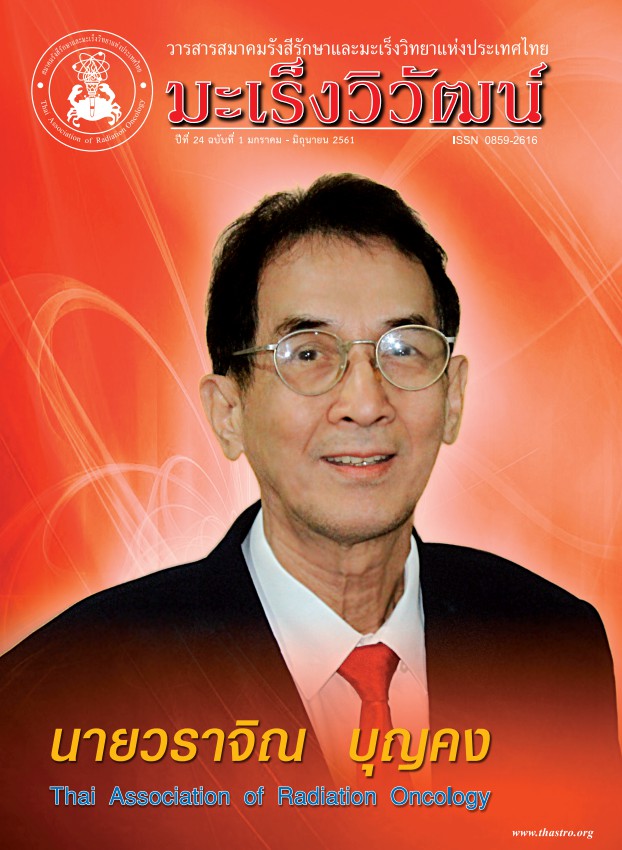The Application of Simulation Technique in Radiotherapy Service Improvement: The Case Study of Maharaj Nakorn Chiang Mai Hospital
Keywords:
Simulation, Health Care, Radiotherapy, Operations ImprovementAbstract
Background: The Division of Radiation Oncology at Maharaj Nakorn Chiang Mai Hospital has a major role in take caring of patients from 8 provinces located at the northern area. The number of patients at this division has increased yearly, but the capability of radiotherapy service is limited. Thus, it is necessary to find improvement solutions for increasing the capability of this service in order to serve more patients. Objective: To propose and evaluate improvement methods for increasing capability of radiotherapy service at Maharaj Nakorn Chiang Mai Hospital. Materials and Methods: To propose and evaluate improvement solutions, it is impossible to conduct experiments under the real situation. Therefore, simulation technique, one tool of industrial engineering tools, was applied in this research. Using simulation, the simulation model for the radiotherapy service was developed. Then, this model was applied for testing the current situation and each solution. The results from the simulation tests can be used in decision making in order to select appropriate solutions for the real implementation in the future. Result: The results from the simulation model of the treatment room no. 2 presented that the largest portion of the total operation time was at radiation process. Other operations are carried out by two technicians, so the number of technicians has an effect on long operation times. Therefore, improvements were proposed to increase the efficiency of the radiation machine and technicians. Three solutions were proposed as follows: (1) increasing the number of technicians from 2 to 3 persons; (2) investing a new technology radiation machine; and (3) adopting 3 technicians and investing a new machine. Then, simulation experiments were conducted to present the results of each solution. The results showed that all solutions can improve the number of patients per day at this treatment room significantly as 9.28%, 56.06%, and 64.01%, respectively. Conclusion: The results of this study can be concluded as follows. Firstly, for short term improvement, increasing the number of technicians from 2 to 3 persons is effective to be implemented with minor increasing in the number of patients per day as 9.28% or 2 to 3 patients comparing with the current number. Secondly, if the hospital wants to increase the number of patients per day at the optimized level, the hospital should consider the second solution that is only to invest a new technology radiation machine. With the second solution, 56.06% increasing in the number of patients per day will be achieved as equal to 13 patients increasing per day. In addition, the results from simulation tests did not present the significant difference between the second and third solutions, it can be concluded that the second solution is more appropriated to be implemented to the real system in the future. The second solution can be considered as a long term improvement plan for the hospital.
References
Kasemset C. and Kachitvichyanukul V. (2007). Simulation-Based Procedure for Bottleneck Identification. AsiaSim, CCIS 5, pp. 46-55.
Banks J, Carson J, Nelson B. L. and Nicol D. Discrete-Event System Simulation. Prentice Hall. 2004; 4e.
ประจวบ กล่อมจิต และ กัญจนา ทองสนิท. การจำลองสถานการณ์เบื้องต้น. กรุงเทพฯ. วิศวกรรมสถานแห่งประเทศไทยในพระบรมราชูปถัมป์. 2554.
รุ่งรัตน์ ภิสัชเพ็ญ. (2553). คู่มือสร้างแบบจำลองด้วยโปรแกรม Arena (ฉบับปรับปรุง). ซีเอ็ดยูเคชั่น. กรุงเทพฯ. หน้า 612.
Downloads
Published
How to Cite
Issue
Section
License
บทความที่ได้รับการตีพิมพ์เป็นลิขสิทธิ์ของวารสารมะเร็งวิวัฒน์ ข้อความที่ปรากฏในบทความแต่ละเรื่องในวารสารวิชาการเล่มนี้เป็นความคิดเห็นส่วนตัวของผู้เขียนแต่ละท่านไม่เกี่ยวข้องกับ และบุคคลากรท่านอื่น ๆ ใน สมาคมฯ แต่อย่างใด ความรับผิดชอบองค์ประกอบทั้งหมดของบทความแต่ละเรื่องเป็นของผู้เขียนแต่ละท่าน หากมีความผิดพลาดใดๆ ผู้เขียนแต่ละท่านจะรับผิดชอบบทความของตนเองแต่ผู้เดียว




